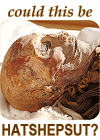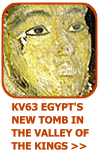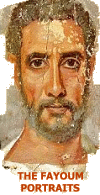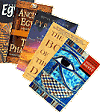|
|
|

Topics in this section: egyptology-how it all began | great discoveries | great egyptologists | rosetta stone
The great discoveries of Ancient Egypt continue to captivate the world, even today.
We've compiled a concise but handy reference of the major discoveries of Ancient Egypt, including the years of discovery, the Egyptologist or person who discovered it, and the area of the excavation or discovery.
In the beginning: 1799-1850
Napoleon's military expedition had only been in Egypt a month when the British secured a naval victory at Abuqir Bay, completely cutting off the French army. Napoleon's team of scholars, scientists and artists made the best of a bad situation by exploring, measuring and documenting everything they saw. As they progressed, one discovery after another followed in an overwhelming succession of monuments and statues. For three years, the team continued, until the final surrender of the French in 1801 when the scholars (or savants as they are also known) could finally return home. In 1828, "Description de L'Egypt" was finally published, a monumental publication of dedicated effort that would spark the birth of Egyptology.
If you use the hyperlinks in the list below, you may sometimes need to use your "back" button on your browser to return to this page.
| YEAR |
MAJOR FINDS |
EXCAVATION AND DISCOVERY |
AREA |
| July 1799 |
The Rosetta Stone. Provided the key to the translation of Ancient Egyptian hieroglyphs. |
Napoleon's Egyptian Expedition, during coastal defence works carried out under Lieutenant Pierre Bouchard. |
North of el-Rashid (Rosetta) on the site of an old fortress known to the French as "Fort Julien". |
| 1813-1817 |
The temple of Abu Simbel. |
Johann Ludwig Burckhardt, a Swiss scholar fluent in Arabic. He persuaded Henry Salt to have the temple dug from the sand by Belzoni. |
Abu Simbel in Nubia. |
| 1816-1818 |
Durham Servant Girl, Clearance of Abu Simbel, Amarna Art, the Late Ramessid Letters, Sekhmet and her many statues. Entrance and burial chamber of the Pyramid of Khafre, Giza. |
Giovanni Battista Belzoni, a hydraulic engineer and circus "strong man", in conjuction with Henry Salt, British Consul general in Cairo. |
Thebes and the Valley of the Kings, tombs KV16, KV17, KV19, WV23 and others, the Pyramid of Khafre at Giza, Abu Simbel dug from the sand. |
| 1820 |
Colossus of Ramesses II (11m/36 ft high). |
Giovanni Battista Caviglia, a Genoese sea captain employed by Henry Salt. |
Ruins of Memphis, the Temple of Ptah. |
| 1820's |
Papyrus treasures including the Turin Royal Canon (king list), the Judicial Papyrus, plan of the tomb of Ramesses IV, map of the goldmines. |
Bernardino Drovetti, the French Consul General. Drovetti and Salt had "divided" the country between them for more efficient exploitation. |
Deir el-Medina, Thebes. |
| 1824 |
Intact tomb and funerary equipment of General Djehuty, who served until Tuthmosis III. |
Bernardino Drovetti, the French Consul General. Unfortunately the contents of the tomb were dispersed without record. |
Saqqara. The exact location is unknown because no records were made at the time of excavation. |
| 1827 |
Tomb of Nubkheperre Intef, the first intact burial of an Egyptian King. |
Egyptian locals. They opened the tomb and helped themselves to various treasures, which later found their way into the British Museum via Henry Salt. |
Dra Abu el-Naga, Thebes. |
Enter the first "Egyptologists" 1850-1881
By the middle of the 19th century, the country's monuments were effectively "under siege" with much that had survived for thousands of years literally lost overnight, and mostly for personal gain. In 1850, the Frenchman Auguste Mariette formed the Service for the Conservation of Antiquities, systematically clearing, detailing and recording each discovery. The result was the amazing collections of antiquities which formed the Egyptian Museum in Cairo, and the beginnings of a regulated discipline.
| YEAR |
MAJOR FINDS |
EXCAVATION AND DISCOVERY |
AREA |
| 1851 |
The Serapeum. Burial place of the sacred Apis Bulls, the "Seated Scribe" statue from the 5th Dynasty. |
François Auguste Mariette and his team. Napoleon's team had earlier searched in vain for the Serapeum. |
Saqqara. Mariette finally enter the sacred catacombs almost a year after his inspired search began. |
| 1855 |
The Harris Papyri, the greatest collection ever discovered. |
Anthony Charles Harris, a British commissariat in Alexander was offered the papyri, discovered by Egyptian locals. |
Thebes, from an unidentified tomb near Medinat Habu. |
| 1860 |
The statue of Khafre (Chephren) builder of the second pyramid at Giza. |
François Auguste Mariette was exploring beneath the paving of Khafre's valley temple when he discovered a pit containing several statues of the 4th Dynasty ruler. |
Giza, the Valley temple of the Pyramid of Khafre. |
| c.1862 |
The Edwin Smith Papyri: Rhind mathematical papyrus, Mathematical leather roll, Ebers medical papyrus and the Edwin Smith surgical papyrus. |
The American Edwin Smith came to Luxor in 1858 and set up as a money lender and dealer. He "acquired" four of the most important scientific texts ever found. |
Thebes. An 18th Dynasty tomb plundered by locals. |
| c.1865 |
The Palermo Stone, fragmentary chronicle of the Egyptian state calendar, with Nile flood levels and the name of the king in whose reign they occurred. |
The stone is in fragments, the main piece in Sicily, some in Cairo, and another in London. The main piece was discovered in Sicily, to which it may have travelled as ballast. |
The piece in London was acquired at the time of Flinders Petrie's excavations at Memphis. |
| 1871 |
The Meidum Sculptures. Remarkable pair of lifelike painted limestone sculptures of Prince Rahotep and Princess Nofret from the 4th Dynasty. |
Discovered by Mariette's assistant Albert Daninos in the mastaba of Rahotep and Nofret. |
Meidum. |
| 1881 |
The Pyramid Texts. The world's oldest religious literature. |
Heinrich and Émile Brugsch. Inscribed on the walls of the Pyramid of Pepi I of the 6th Dynasty. |
Pyramid of Pepi I at Saqqara. |
Expansion and controlled excavation: 1881-1914
Auguste Mariette was succeeded by Gaston Maspero in 1881. Under his directorship, the archaeological exploration of the Nile Valley was set on an international footing. This was the era of tourists and grandees, and saw the emergence of scholars such as Flinders Petrie, Lord Carnarvon and Howard Carter.
| YEAR |
MAJOR FINDS |
EXCAVATION AND DISCOVERY |
AREA |
| 1881 |
The Royal Cache of Mummies. Amazing collection in excess of 50 mummies of kings, queens, lesser royals and courtiers, including such greats as Ramesses II and his father Seti I. |
Local Abd el-Rassul family discovered and plundered the cache, selling objects, including a mummy on the black market. Émile Brugsch was investigating the source of these objects. |
Deir el-Bahri, Thebes. |
| 1887 |
The Amarna Letters. A cache of cuneiform tablets of correspondence between the pharaohs Amenhotep III and Akhenaten and their Near Eastern neighbours. |
A local woman digging ancient mudbrick for use as a fertiliser (sebakh). Their importance was not immediately recognised until Wallis Budge from the British Museum purchased a number of them. |
Tell el-Amarna in Middle Egypt, the site of Akhenaten's city of Akhetaten. |
| 1888 |
The Faiyum Portraits. Lifelike portraits once bandaged over the face of Roman period mummies. |
Earlier finds had been available in tempura, however Flinders Petrie discovered a batch of over 60 beautifully drawn Roman period mummy paintings. |
Faiyum site, near Hawara, approx. 60kms south-west of Cairo. |
| 1891-1892 |
Paintings from the Palace at el-Amarna. An amazing collection of Amarna Art. |
Flinders Petrie was the first to excavate the site at el-Amarna, assisted by a young Howard Carter. |
Tell el-Amarna in Middle Egypt. |
| 1896 |
The Israel Stelae. The only reference to the tribe of Israel in any Egyptian text: "Israel is laid waste! Her seed exists no more!" |
Uncovered by Flinders Petrie in the mortuary temple of Merenptah, carved on the reverse of a stelae originally prepared for Amenhotep III. |
Thebes. |
| 1897-1899 |
Hierakonpolis, "city of the falcon god". A collection of statues, some in gold, Narmer Palette, dating from the Early Dynastic Period. |
James Quibell and Frederick Green. The most significant find was the Narmer Palette which showed the king wearing the red and white crowns. |
Kom el-Ahmar, (Hierakonpolis). |
| 1898-1899 |
Tomb of Tuthmosis III, tomb of Amenhotep II, and a second cache of royal mummies. |
Victor Loret, director general of the Egyptian Antiquities Service, excavating in the Valley of the Kings. |
Valley of the Kings, Thebes. Tombs KV34, KV35, KV36, and others. |
| 1896-1906 |
The Oxyrhynchus Papyri, a collection of Classical works, including early Christian texts. |
Bernard Grenfell and Arthur Hunt. The papyri were discovered inside a mummified crocodile. |
El-Bahnasa (Oxyrhynchus). |
| 1903 |
The Karnak Cachette, the largest ever find of statues, dating from Early Dynastic to the Greco-Roman period. |
Georges Legrain, working under the supervision of Gaston Maspero. Finds included the famous statue Tutankhamun as the god Khonsu. |
Karnak Temple, Thebes (Luxor). |
| 1904 |
The tomb of Nefetari, principal wife of Ramesses II. |
Ernesto Schiaparelli, director of the Museo Torino. The tomb is famous for the sheer brilliance of its decoration. |
Valley of the Queens, Thebes. Tomb QV66. |
| 1908-1910 |
The statues of Menkaure, builder of the third pyramid of Giza. |
George Reisner, the "American Petrie" |
Menkaure's pyramid and valley temples, Giza. |
| 1912 |
The workshop of the royal sculptor Thutmose. The famous unfinished bust of Nefertiti, seated statue of Amenhotep son of Hapu. |
Ludwig Borchardt and his team of German archaeologists, excavating at el-Amarna after Flinders Petrie. |
Tell el-Amarna (Akhetaten), Middle Egypt. |
| 1914 |
Hidden treasure of Sithathoriunet. A spectacular hoard of Middle Kingdom jewellery and cosmetic containers. |
Flinders Petrie excavating the Middle Kingdom subsidiary tombs of the Pyramid of Sesostris. |
Pyramid necropolis of El-Lisht. |
More great discoveries in Egypt >>
|
|
|








